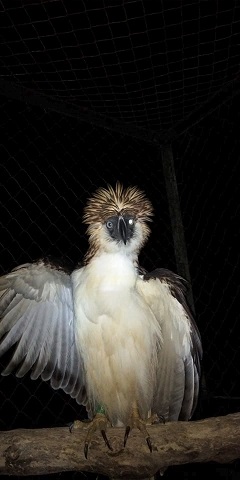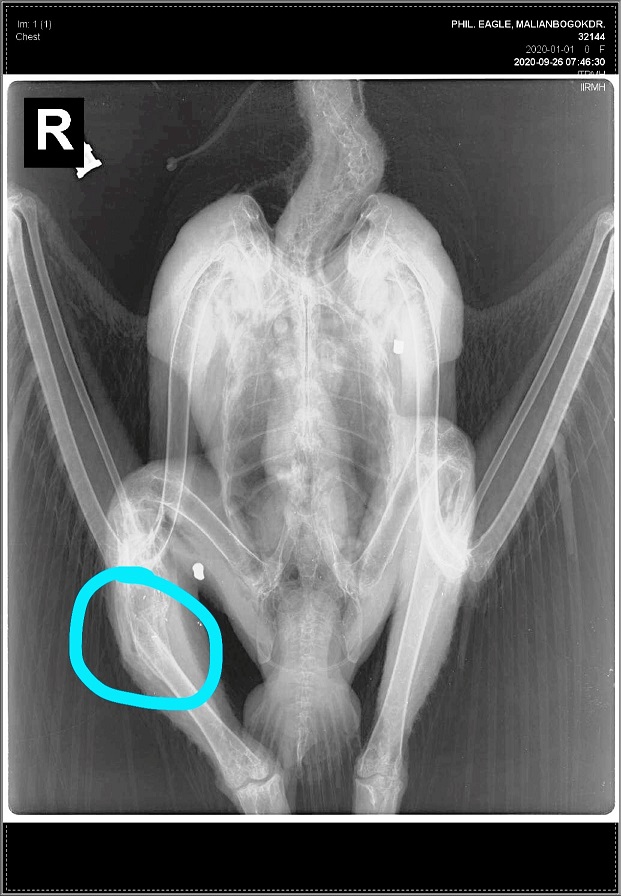SEVEN individuals of the “critically endangered” Philippine eagle were rescued since the COVID-19 lockdowns and quarantines. One died of malnutrition; three were released back to the wild; and three are currently under rehabilitation. Here are their stories:
“Mal-lambugok”

It was July 30, and Mangkatadong Agusto Diano, Tribal Chieftain and Head Forest Guard of the Indigenous Mandaya community in Caraga, Davao Oriental called to report a captured eagle. A fellow Mandaya trapped the eagle after the bird allegedly killed his livestock. The captor claimed it was already the fourth piglet killed by the eagle.
We drove seven hours the following day and arrived at PM Sobrecarey in Caraga mid-afternoon. Then, we took a 3-hour motorcycle ride over the worst road you can imagine to get to the remote, satellite village of Tagbanahao where the bird was kept.
At Tagbanahao, the bird was inside a chicken cage right in the middle of a noisy crowd of villagers. There was no social distancing and very few were wearing a face mask. We covered the cage with a huge towel to calm down the already super-stressed bird.
The village leaders prepared snacks for our team. We were famished so we munched on the native cakes and sipped hot coffee before we went on to work. We briefed everyon about our procedures and explained the program to save the eagles and the laws that protect it. When everyone looked convinced, we restrained the bird and left before dusk.
We spared the bird from the back-breaking motorcycle ride and walked instead. With its eyes covered by a leather hood and its body wrapped in elastic bandage, the bird was cradled like a sleeping baby. It took us two hours of downhill trek to reach the main village with only headlamps lighting our way. After a quick inspection by Dr. Lascano, and a rushed dinner, we headed home with the bird.
But the bird manifested psychological trauma at the Philippine Eagle Center (PEC). It went restless at the slightest human sound. For the first five days at the center, it ignored food rations. On the fifth day, the bird was examined and forced-fed. From 5.8kgs when the bird was captured, his weight fell to 4.8kgs. Thankfully, she began eating on its sixth day, and each day thereafter. She slowly gained back her weight.
Passing x-ray and agility tests and clean of deadly viruses, eagle Mal’lambugok was cleared for release. 28 Indigenous Mandaya forest guards were trained by DENR and PEF as Wildlife Enforcement Officers (WEO) whose job is to monitor Mal’lambigok and ensure her well-being. DENR and the local governments of Davao Oriental and Caraga gave their share and provided funds for education campaigns, and field gears, food rations and honorariums to the local WEOs.
Mal’lambigok was released on September 26, as the world celebrated World Environmental Health Day. She was cheered on by over 100 guests and local residents. And her indigenous caretakers prayed to the spirits of the forests to keep her healthy and safe from harm.
“Balikatan”

Another concerned citizen sent PEF a messenger text on August 28 about a Philippine eagle that is under the care of his cousin. Because we get plenty of these kinds of messages, I was skeptical. But just the same, I requested for a photo. In a few minutes, the photo appeared in the thread, and my heard raced when I saw that it was a Philippine eagle!
The bird was in Bacuag, Surigao del Norte, and was under the care of Ryan Orquina, an outdoor enthusiast. Orquina bought the bird from an indigenous Mamanwa bird trapper that he knows only by the name of ‘Dodong.” He paid Php 8,000.00, but he believes it’s a small price to pay considering that it meant saving one individual of our national bird from possible serious, if not fatal, injuries.
After being tested negative for COVID-19, and their medical certificates secured, PEF vet Ana Lascano and her rescue team left Davao City past midnight of August 29. The team redezvoused with DENR staff in Butuan City and the composite team drove further north and reached Bacuag town around lunchtime.
Orquino confessed he had the bird for almost three weeks. And that he fed it with chicken and rats, and also sea snakes caught from his fishponds by the sea. He also thinks the bird was kept for several weeks by its Mamanwa captor before the Indigenous fellow sold it.
The bird weight 3.8kgs, immature (at least 3 years old) and is male, interestingly, the bird was docile. It was restrained easily. It semed comfortable with being handled by people. X-ray showed neither injuries nor abnormalities. Disease tests were also negative. The bird seemed healthy, but it was half blind.
Standard ophthalmic test showed that its left eye can’t see. Sadly, the other eye is also showing early signs of a possible cataract. Our rehabilitation team at the PEC is working remotely with two US Vet consultants to save the bird’s right eye. But with its current condition, he could no longer be released back to the wild.
“Caraga”

On September 25, a day before we released “Ma’lambugok” back to her forest home in Barangay PM Sobrecarey in Caraga, we got a phone call that another eagle was trapped at Sitio Tagbanahao – the same place where Mal’lambugok was rescued from. The new bird also killed a piglet and its captor retaliated by trapping the bird.
With the help of Indigenous WEOs that LGU Caraga, DENR and PEF have just recently trained, the new eagle was safely transported to the main village. It was then housed inside a spacious room while awaiting veterinary care.
We left Davao City past midnight on September 26 with eagle “Mal’lambugok,” and arrived in Sobrecarey at dawn. PEF Vet consultant Bayani Vandenbroeck examined the new eagle, while we drove further up the mountain to prepare for Mal’lambugok’s release. If the new bird turns out healthy and releasable, we will release it with Mal’lambugok. A spare GPS tracker was assigned to the new bird. Unfortunately, the new bird was in bad shape. It weighed only 3.6kgs (underweight for its age of 3-4 years old), was dehydrated, and seemed to have not eaten for days. Also, it did not resist handling and was unafraid of people. Contrary to the captor’s claim, the bird seemed to have been caged for a while now. We brought the eagle patient with us to Davao City after we have released Mal’lambugok.
In Davao City, x-ray plates revealed more of the new eagle’s miseries. It had two air gun pellets embedded inside its body; one at the left chest, and another at its right thigh. But no punctures were visible, which indicated that the entry wound has healed and that a long time has passed since the shooting happened.
The bird also had a fractured right leg, which explained its awkward posture as seen from photos uploaded by its captor on Facebook. The muscles and ligaments around the fracture appeared to have healed as well. And this further supports the suspicion that it has been held captive for quite a while now. A wild eagle with leg injury could not hunt and survive in the wild. The only way it could make it this far is if someone caged and fed it.
As of this writing, the DENR is gathering evidences for a possible filing of a criminal case against the captor who violated wildlife laws.
You might want to read:
– Lockdown tales of 7 Philippines eagles (Part 1 of 3)
– DENR releases 13 rehabilitated wildlife
– Philippine hawk eagle rescued and turned over to DENR





